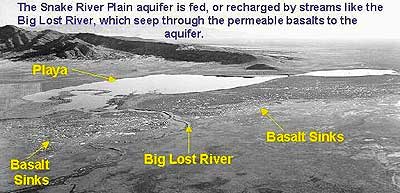
 |
|
Photo
courtesy of the National Park Service
|
The Snake River provides an excellent example of a river fed by ground water. As the Snake River flows across southern Idaho much of the flow is diverted for irrigation. At Shoshone Falls, about 30 miles downstream of Milner Dam, the river may nearly dry up due to irrigation diversions. In the next 40 miles downstream, the river is again “reborn” in the impressive Thousand Springs area, where springs collectively discharge more than 5,000 cubic feet per second. Niagara Springs is an example of the many scenic springs in the Thousand Springs area. These river “gains” provide the majority of the downstream flow during summer.
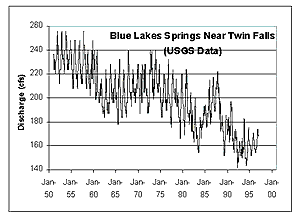 Discharges
from springs are often relatively constant, but may fluctuate with the season
and from year to year, depending upon natural weather patterns and man-induced
effects of pumping and irrigation.
Discharges
from springs are often relatively constant, but may fluctuate with the season
and from year to year, depending upon natural weather patterns and man-induced
effects of pumping and irrigation.
Discharge of Blue Lakes Spring along the Snake River near Twin Falls shows both seasonal and long-term variation. Much of the short and long-term variation in the flow of Blue Lakes Spring is due to distribution and application of water from the Snake River for irrigation and ground water pumping.
In some situations, river seepage (losses to the aquifer) may be affected by ground water pumping and natural variations in aquifer water level. When the aquifer water level is near land surface, seepage from the river is partially controlled by the height of the aquifer water level, (see losing stream illustration). Activities or events that result in a lowering of the water table, such as ground water pumping, induce more seepage from the river.
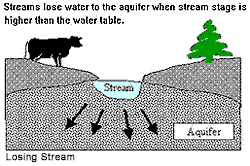 |
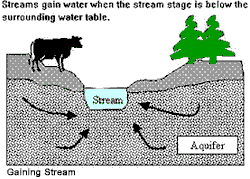 |
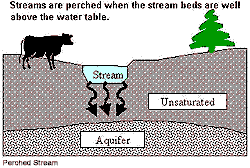 |
|
Losing
Stream
|
Gaining
Stream
|
Perched
Stream
|
Conversely, events that cause the aquifer water level to rise (recharge events) will result in a decrease in river seepage. If aquifer water levels rise above the level of the river, what was previously a losing river reach will become a reach that is gaining water from the aquifer.
Another hydrologic condition exists that is very important in understanding surface and ground water interaction. A surface water body is “perched” above an aquifer when aquifer water levels are well below the bed of the river, stream, or lake (see perched stream illustration). Under these conditions, water will seep from the surface water body to the ground water, but the surface water body will not be affected by aquifer water levels and consequently does not change in response to ground water pumping. Nearby ground water pumping will cause a lowering of the water table, but will not affect surface water supplies.
In summary, any of three conditions may exist that determine if, or how, ground water use may affect surface water resources. These conditions are:
1) an interconnected river (or lake) and aquifer, where the river is losing water to the aquifer,
2) an interconnected river or lake in which the river or lake is gaining water from the ground water, and
3) a perched river which is losing water to the aquifer.
In the first condition river losses will increase in response to ground water pumping. In the second condition, river gains will decrease in response to ground water pumping. In either case, ground water pumping will result in a depletion or capture of surface water. In the third case, ground water pumping has no impact on surface water resources. All these conditions may exist in the same river or lake at different locations or times of year.